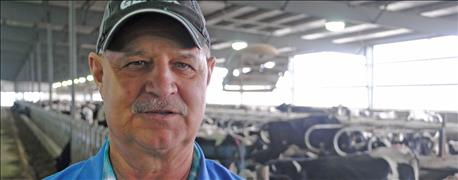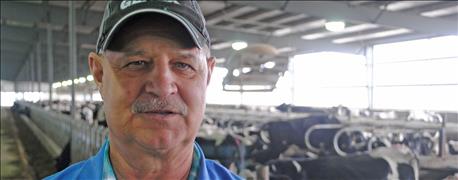
Nebraska dairying is on the way up. That's the word from Nebraska State Dairy Association Executive Director Rod Johnson. "We are seeing dairies grow and bring their next generations into a viable and productive dairy community," he says.

HAPPY COWS: Bill Thiele, Clearwater, says that their family dairy focused strongly on increasing comfort and reducing stress for milk cows when they designed and built their new milking parlor and freestall barn facilities.
One of those expansions and transitions to the next generation of dairy operators is occurring at Thiele Dairy near Clearwater. At a recent open house for their new dairy facilities, the family hosted over 1,500 people who viewed their new milking parlor and freestall barns. Dairying has been in the Thiele family for generations. Currently, the dairy is operated by Bill Thiele, his brother Tom, and another brother Ron and his wife, Karol. More recent family additions to the operation have been Tom's son, Scott, and his wife, Cecily, and Ron and Karol's son, Luke, and his wife, Morgan.
The family started planning for the new facilities while they were building their former barns several years ago. That's the way it has to be to prevent wasting time and investments, Bill Thiele says.
Thiele visited several other dairies in the planning process in Wisconsin and other states to get ideas. They settled on a plan that included a large enough milking parlor — a double 35 — that can milk up to 35 head on each side at the same time. Although they don't have enough cows to fill the parlor now, the family was thinking about the future. They added a freestall barn with recessed feed bunks built into the alleyway, to save time and effort in pushing up feed to the cows. It also includes a unique misting system that cools the air in the building without getting the cows and concrete wet, therefore preventing health and sanitation issues.
They added another manure lagoon, and manure and sand separators to the facility to prevent odor, fully utilize waste, and save water and sand used in the operation. Before the expansion, the family was milking early-lactation cows at the home dairy and late-lactation cows at another location, with a total of 1,250 head for two sites. The recent upgrades allow the family to milk 1750 cows at the home dairy site.
"We built the parlor big enough so we could expand numbers over time," Thiele says. "We are permitted for up to 2,800 head." The structures and amenities of the facilities were built to improve the health and longevity of the animals. "We want every cow to reach her growth and production potential," Thiele says. "We got them inside out of inclement weather so they don't have to endure the extreme heat of summer or the cold of winter," he says. "Milking three times per day, our facilities have allowed us to shorten their time in the holding pen waiting to be milked, and we can see the results with more relaxed cows and a great improvement in conception rates."
The facilities were built for cow comfort, with state-of-the-art ventilation, and thermostat and humidistat air controls in the freestall barn. The barn also includes a large veterinary room complete with large windows, so dairy workers can treat animals when needed, but they can also see what is going on in the stalls. The stalls themselves are more spacious, allowing cows to lie down in deep sand when they want.
"The cows are much more relaxed than in our old facilities," Thiele says. "Things are quieter. You can look out over the freestall barn at any time and see a majority of the cows lying down and relaxing." Relaxed cows are also healthier. Because of their computerized tracking system from birth, the Thieles know right away through monitoring if a cow's production numbers are off and if there could be a health issue arising before it even shows up as symptoms.
The new facilities also save water by recycling almost every drop. The same water is used several times to water cows, cool the milk, clean the milking parlor, flush freestall barns, and eventually be pumped from the lagoons and chiseled into the soil to provide nutrients for crops, Thiele says. "We also recycle over 90% of the sand," he adds.
Finally, the facilities have improved the comfort of dairy employees. With indoor, climate-controlled and sanitized facilities, workers enjoy the same comfort at the job as the cows.
The Thiele Dairy expansion is just one example of a dairy industry on the rise, Johnson says. "New technologies, such as robotics, are being incorporated, which brings a new perspective," he says. "Currently, the only roadblock we are facing is opening markets and value-added processing," Johnson explains. "As we move forward to break through that roadblock, the future for dairy in Nebraska looks bright."
Learn more about Thiele Dairy and the dairy industry in the state at nebraskamilk.org or by attending the annual NSDA convention scheduled for Feb. 21 in Columbus.
About the Author(s)
You May Also Like






